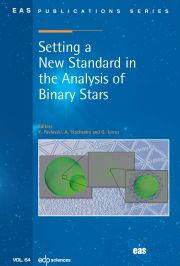Article contents
The Effects of Stellar Rotation and Magnetism on Oscillation Frequencies
Published online by Cambridge University Press: 20 June 2007
Abstract
Stellar rotation and magnetism are two phenomena which intervene in manypulsating stars. As a result, calculating their effects on stellar pulsationshas been the subject of active research for a number of years, and many resultshave emerged. For instance, slow stellar rotation lifts mode degeneracy andleads to evenly spaced frequency multiplets. At rapid rotation rates, a neworganisation of the frequency spectrum appears, in which the centrifugal forceplays a dominant role. Stellar magnetism plays an important role on pulsationfrequencies both directly and indirectly. Various studies show how magnetism canshift frequencies and play on mode excitation and selection. Magnetism alsointroduces other types of waves with a different frequency spectrumorganisation.
Information
- Type
- Research Article
- Information
- Copyright
- © EAS, EDP Sciences, 2007
- 1
- Cited by

